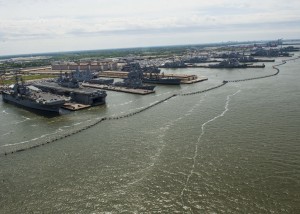2013-06-05 We have just published a new Special Report. This one deals with Bold Alligator 2013 and complements an earlier one on Bold Alligator 2012.
This exercise tested out how to shape new ways to forge a capable insertion force using the seabase. Especially noteworthy has been the testing of approaches for seabase support to the ground forces. Indeed, the challenge has been to mix the deployed forces with the proper support element.
A light logistics footprint has meant that the overall force protection and support requirements have been reduced. Rather than building mobile Walmarts, which then need to be protected, the model here is to support the engaged force with the right equipment and right supplies at the right place.
A key challenge facing the U.S. and its allies is to ensure that the politicians and strategists understand this new and evolving flexibility and shape proper understanding of when and how to use this capability.
For example, with regard to Syria, the positions taken have largely been either to do a significant land insertion to support the “rebels” or to put red lines in the sand to ensure that chemical weapons are not used.
Not discussed at all was how might we use this new flexible force to go in and grab the weapons one can and leave, without fully resolving the fate of Syria for the 21st century.
Limited objectives, limited means but robust capabilities provide policy options, if the policy class puzzles over evolving capabilities.
As the United States faces the future and needs to come to terms with the past decade, what will be its military strategy? The answer to this question is not likely to come in briefing slides but in shaping concrete steps towards the future as well as in shaping responses to new and ongoing crises.
Although nationally based, any U.S. military strategy for the decade ahead and beyond will be dependent on what U.S. allies and adversaries do. It will not be forged in a vacuum. It will be highly interactive with the shaping of new operational concepts and approaches.

Indeed, when the United States deals with a massive challenge such as shaping a strategy for the vast Pacific with limited assets, it is impossible to imagine a strategy that does not build from allies back to the United States and from the United States back to allies. Critics, who point out the shortfalls of US forces, often forget that not only does no platform fight alone, but also neither will the U.S. in the Pacific.
And there is always the reactive enemy. Often the term is used of an asymmetric enemy or strategy. But strategy is usually asymmetric, as one seeks to enhance one’s advantages to the disadvantage of the other. And this occurs the other way as well, whereby the U.S. and its allies can shape capabilities that severely disadvantage an adversary.
With financial pressures has come a new pessimism, which seeks to reduce the problems facing the U.S. to those that can be solved by yesterday’s force structure. But with the force being remade by new technologies ripening in the decade ahead, there are significant possibilities for innovation and re-shaping of the force structure.
But the decade ahead is assuredly not the decade behind. Most notably, this is not a decade of the type of land wars we have just seen, which are ending without enthusiastic chants of victory.
Because allies are more central to the successful execution of American political-military strategy in the decade ahead than in recent history, how those allies re-shape their forces and innovate will be central as well to the broader understanding of “American” strategy.
But this does not happen without introducing new systems, reshaping capabilities and crafting an effective force for the 21st century. The United States, and its Allies need to analyze, conceive, and then build towards the force for the future.
We have seen recent engagements as coalitions, and thus the inter operation of command and control, as well as the implementation of force elements need training and practice.
Indeed, in key exercises this is what the United States and its allies are indeed doing. Exercises such as the Bold Alligator series in which the USN-USMC team lead a joint and coalition effort to shape a flexible insertion force are being used precisely to determine the kind of C2 and ISR capabilities needed in the future.
For example, the exercise highlighted the core need for the coalition force to be able to craft over time greater capability to transfer the deconfliction of air tasks to integrated data systems. Strike and air de-confliction requires significant coordination, and more automation of the data generated will over time assist in the improved flow of force through the deployed ships.
For our look at the Bold Alligator 2013 and its evolving context pleas read our Special Report.
https://sldinfo.com/bold-alligator-2013-shaping-a-21st-century-insertion-force/

